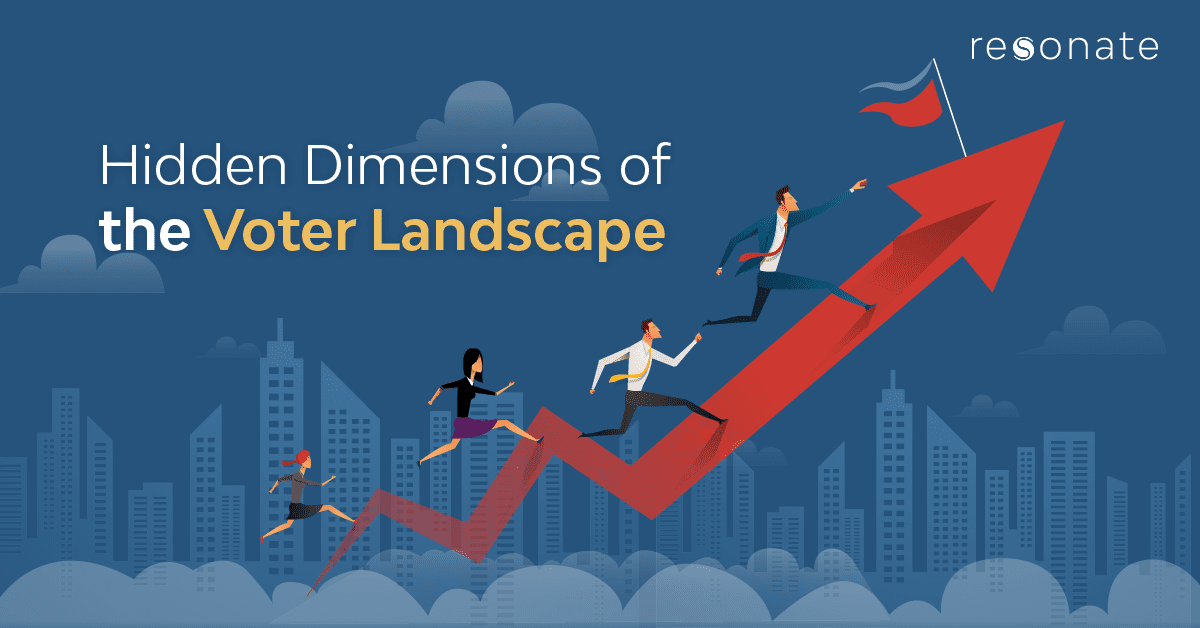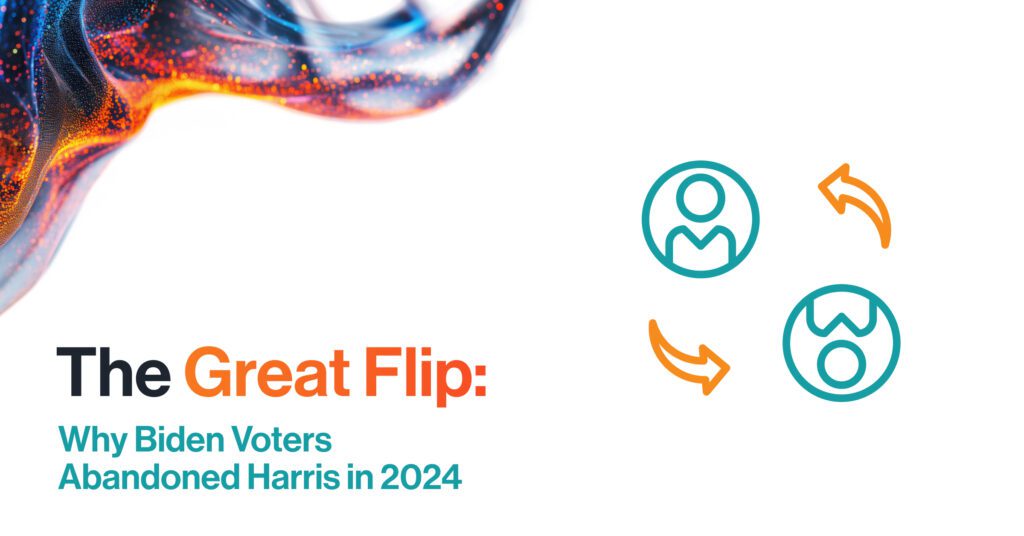The Key to Victory in 2020: Moving Beyond the Voter File
When President Trump invited Kim Kardashian to the White House to discuss prison reform in 2018, the photo opportunity got coverage, but there was actually a more important mission underway.
It turns out the invitation was extended with a specific communications objective in mind: Reach and engage one of the largest and most ignored voter segments in the American electorate, what we term the Resonate Common Centrists. The event connected with this hard-to-reach voter, which was unearthed in Resonate’s groundbreaking Voter Landscape© e-book, and contains 17.1 million highly persuadable voters.
Voter Segmentation is Entering a New Era of Granularity
Resonate Common Centrists are 9.3% of the U.S. adult population and there is no way to isolate and target them through the voter file alone. In fact, evidence suggests that this segment only votes when specifically motivated to do so, which explains the strategy behind the Kardashian invite to the White House. They are a group who tends to trust their gut instinct first, support First Amendment protections and are driven by protecting their family, personal property and possessions, as well as ensuring financial stability.
Powerful insights like these aren’t available in the voter file alone—it must be combined with third-party data paint a more complete picture. But this is a messy and error-prone process that simply cannot deliver the intimate level of granularity available from machine learning and AI-powered platforms. Can the voter file tell you which of your target constituents believe that being down-to-earth is an important trait in a candidate? Understanding online user behavior and combining it with statistically sound survey data can. What else can machine learning and AI-powered platforms tell you about these ‘Common Centrists’?
- 56% are women
- They watch “Keeping Up with the Kardashians”
- 24% of them are 45-54 years old
- Most do not spend any time per week reading newspapers online
- 21% have a household income between $100-$150K annually
- 66% are married
- 44% have children
- 38% have a college degree
What other media do they use both online and offline? How do they feel about abortion rights or specific presidential candidates? These insights and much more are available in the Resonate platform.
What Other Unknown Voter Groups Exist?
This is only one of nine voter segments Resonate identified during its groundbreaking 2018 voter analysis. Applying AI to survey data and online behavior revealed eight other Resonate voter segments:
- Lost Libertarians, who are the most politically disengaged segment
- Global Liberals, the youngest and most racially diverse segment on the political left
- Conservation Conservatives, a surprisingly pro-environmental conservative segment
- New Nationalists, the strongest believers in “America First” segment
- Impartial Persuadables, the youngest segment and an enticing 13.6% of the electorate
- Professional Progressives, who are the most well educated and wealthy segment
- Loyal Lefties, the most liberal and Democratic-leaning segment
- Cautious Conservatives, a young and persuadable segment of right-leaning voters.
Each of these segments exists at a level of analysis that the voter file cannot match, and by digging into this powerful, informative data, you’ll begin to understand the values and motivations of these segments – often with surprising results. And, in turn, this insight can inform your strategy, targeting, messaging and creative in order to produce better results.
For example, while Loyal Lefties are the most aligned to the Democratic party, they also are more likely than New Nationalists, the most conservative segment, to support civil liberties, often seen as a bastion of traditional right-leaning ideals. This group is also even more likely to support Trump’s infrastructure plan than the New Nationalists, by almost a two-to-one margin. Again, this flies in the face of traditional political ideology.
So, what does this all mean? Clearly, the voter landscape is fractured from its former foundations, evolving into a different reality, one that is much more segmented and nuanced than can be gleaned from the flat voter file.
The Hidden Dimensions of the Voter Landscape© are Changing the Science of Voter Segmentation
Dan Scantlebury, PhD, Director of Data Science at Resonate, has done deep and extensive research on the voter landscape, and the findings have been surprising, including several new hidden dimensions that defy existing political convention in the world of voter data and segmentation. Some of them include:
Hidden Dimension: Deniability. This dimension is centered on the ideas that humans did not cause climate change and that Russia did not interfere in the 2016 presidential election. While there was a bit of a left/right divide on the issue, the division is much less than we anticipated. There are several areas of crossover between that position and people who self-identify as liberal or conservative.
Hidden Dimension: Support for “Blue” (aka Green) Tax Policies. This includes somewhat controversial issues such as legalizing and taxing recreational marijuana. This cause is traditionally viewed as one supported by the political left and derided by the political right. The truth is much more nuanced, and many constituents who would be labeled conservative, in truth, probably support legislation in this direction. Additionally, the issue is more divisive among the political left than most people think, which means there’s room to persuade people on both sides of the political spectrum in one direction or the other.
Hidden Dimension: Party Registration and Age/Gender. The politically astute among us have probably heard the old maxim, “If you are not a Liberal at 25, you have no heart. If you are not a Conservative at 35, you have no brain.” The truth is much more complex. While conservatives tend to be older and liberals younger, there are many Americans who move in the opposite direction. Additionally, women and men have always been divided when it comes to liberal and conservative viewpoints, but this is also quickly changing.
Hidden Dimension: Human Rights and Media Consumption. There is a large group of voters who watch international news but are apathetic toward human rights. Does this sound conservative to you? You may be surprised at how evenly split among party lines this issue is among American voters.
Hidden Dimension: Empathy – Civil Rights and Environmental Policy. This segment is incredibly surprising, where many on the far right and far left are actually aligned in their support for civil rights and environmental policy. On this issue, the hidden element is that the people closer to the center of the left/right divide are less interested in supporting candidates who care about these issues, making them more persuadable on the issues in mainstream America.
The risk of using the voter file exclusively for segmentation, targeting and marketing to voters is that it can’t expose these elements of the voter landscape. The voter file doesn’t give you an understanding of the why behind human behavior. The Resonate platform sees these connections due to the neural networks that are used in machine learning analysis of survey data and online user behavior.
In a media landscape where mass communication is increasingly an outdated model, tailored communication at the individual level, combining insights such as the Resonate Voter Landscape© and its hidden dimensions, is critical to being able to persuade voters to support your cause or candidate, or galvanize support among constituents who already align with your campaign.
How to Move Beyond the Voter File in the Pursuit of 1:1 Candidate to Constituent Engagement
When you consider that most voter data are collected offline and rely on third-party appends to complete a profile of constituents, it immediately paints a picture of data that are unreliable, two-dimensional and limited in scope, which limits their value and relevance.
Powered by machine learning and AI, the Resonate platform turns this two-dimensional view into a three-dimensional playing field, combining voter preference and past behavior with one of the largest pools of survey research available on the American voter. It’s then connected to a real-time understanding of online user behavior. The platform also allows for seamless omnichannel targeting of the segments, enabling political and advocacy campaigns to communicate with and persuade voters within a matter of minutes, directly through the channels where they spend the most time.
Ready to learn more? Book a Demo today to see how it works.



